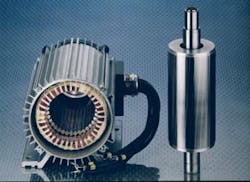New technologies change our lives daily; what was top of the line yesterday is outdated today. The same applies to traction drive technology for battery powered material handling and ground support equipment. Not long ago DC separately excited motors were considered the latest technology. Today, low voltage AC induction motors controlled by state-of-the-art DC to AC inverters completely revolutionize electrical vehicle traction drives.
WHAT IS AC TECHNOLOGY?
AC stands for Alternating Current. Using 3-phases, it can be wound in voltages from 9 to 48 (low voltage) to 110 to 575 volts (standard high voltage.) The motor consists of a stator (housing with fins, stator lamination and copper winding) and a rotor (rotor lamination and aluminum die cast squirrel cage; this is the reason it is also called a squirrel cage motor). End shield, bearings and terminals complete the motor. It is a very simple and efficient motor design (see Pict. 1).
Typical characteristics of AC motors are shown in Diagram 1 with the working area highlighted in red. Motor torque is determined by the voltage and constant from zero speed to the base frequency point (see Diagram 2). At higher speeds in the field weakening area the torque is reduced.
The AC induction motor torque/speed behavior matches the typical traction drive demands for most electrical vehicles. Maximum torque is needed in lower speeds for acceleration or ramp operation while reduced torque is sufficient for higher speeds.
Varying the frequency on an AC sinus curve changes vehicle speeds. The faster a vehicle travels the higher the frequency; the slower a vehicle travels the lower the frequency. AC inverters use speed feedbacks and special algorithms to operate the motor in the most efficient way on any particular speed/torque point.
WHY AC TECHNOLOGY IS USED ON THE RAMP
Control Behavior: Hooking up a trailer or positioning a vehicle closely to a specific location can be time consuming and annoyingly difficult when the delayed torque availability of DC power causes the vehicle to jerk. This is completely eliminated with AC induction motors, which shine with full torque and smooth operation from zero speed.
Systems Efficiency: Brushes limit allowable DC motor speeds. AC induction motors do not require brushes and can be safely operated at higher speeds. Increasing gear ratios to match optimum speed ranges for AC induction motors and using regeneration modes to recharge batteries can improve overall system efficiencies by up to 15 percent.
Maintenance Cost: Motor maintenance should be considered in determining overall operating cost of a traction drive system. AC induction motors are extremely robust and not sensitive to temperatures or centrifugal forces because no rare earth magnets are used in AC induction motor designs. Motor Performance and Protection: AC induction motors are externally cooled; no internal airflow is needed to clean brush dust out of the motor. The performance is not reduced by enclosing the motor to meet UL EE protection class. OEMs can now offer all their vehicles with UL EE version motors at no extra cost or performance penalty. This is especially important and beneficial for the outdoor use GSE is being exposed to.
Operation with Low Battery: DC motor powered vehicles will simply come to a complete stop if battery voltage drops below a certain level. Vehicles equipped with AC induction motors will always be able to “limp” back to a charging station. Either full torque at reduced speed or full speed at reduced torque can be called upon even with a low battery, which increases the operational safety of AC induction motor equipped vehicles under any battery condition.
AC TECHNOLOGY APPLICATIONS
For more than A decade the AC technology has been embraced in Europe. AC induction motors have been sourced not only for material handling applications but also tow tractors. TLD has been successfully using AC induction motors for years for their electrical tow tractors.
Here in North America, Harlan Corp. started installing AC induction motors a few years ago and recently received a repeat order from a very satisfied large industrial user. “My customers immediately embraced the new technology and appreciate the better performance and control behavior of our AC tow tractors,” states Jamie Kaplan, CEO of Harlan. A similar experience occurred at Taylor Dunn. “Our updated Husky tow tractor with AC traction motor easily outperforms the previous DC sepex version,” states Andrew McNiven, senior electrical engineer. ”Superior controllability and efficiency improvements make AC the best choice for traction applications.”
OUTLOOK FOR THE FUTURE
With increased delivery volumes, inverter cost will continue to decrease and the AC technology will become an even more economical traction drive solution. Sensorless AC controllers have been developed and are now available.





